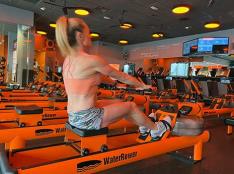
By clicking on the product links in this article, we may receive a commission fee at no cost to you, the reader. Sponsorships and affiliate commissions help support our research so we can help you find the best products. Read our full affiliate disclosure here.
When it comes to physical fitness, science and research are constantly evolving. Compared to a subject like physics, which has had thousands of years of research, exercise science is a relatively young field with less than 50 years of dedicated study.
A newer topic coming to the forefront of training jargon these days is Heart Rate Training (or HRT). Popular fitness studios like Orangetheory Fitness even center all their workouts around heart rate training. HRT may sound complicated and a bit "science-y," but we promise it's as simple as tracking your beats per minute. We’ve previously discussed how to use heart rate training in your programs and how to calculate your heart rate zones in other articles, but for this piece, we want to explain the science behind heart rate training and the benefits of incorporating this in your workout program.
Attach your heart rate monitor, and let’s get started!
What is Heart Rate Training?
When exercise professionals or scientists describe training sessions, they want to be as objective as possible. There’s a lot of math involved in determining the effectiveness of a workout, and one of the main components of that arithmetic is “intensity.”
Intensity is a crucial textbook term in exercise training; it describes the percentage of maximal effort you’re working at. Many people are familiar with one rep maxes in strength training, and intensity is typically based on that. If your coach or trainer asks for 3 sets of 10 squats at 60% of your one rep max, your intensity is 60%. So, how can we accomplish this with running or endurance training? Loads of ways! You can train at percentages of your VO2 max, lactate threshold, or other scientifically derived targets. However, not everyone knows their VO2 max, and not everyone has a research team constantly checking their blood lactate while training.
So, what’s the easiest method? Heart rate training, and more specifically, using heart rate zones. At Orangetheory Fitness, new members are encouraged to use their HR and rate of perceived exertion (RPE) to determine their intensity.
Heart Rate Training Zones
There are several ways to estimate your maximum heart rate, and none are perfect. Your max heart rate is influenced by your age, gender, body mass, and overall health—not to mention your mental state, stress level, or environment. To keep things simple—the easiest way to estimate your maximum heart rate is by subtracting your age from 220. If you’re 40, your heart rate will be 180 beats per minute. Now you can prescribe endurance training intensities based on percentages of your heart rate!
Luckily scientists and coaches started doing this years ago, and we have a range of zones that we can prescribe to elicit specific adaptations. Let’s cover each zone more in-depth:
Zone 1
The American College of Sports Medicine (ACSM) has outlined five heart rate training zones.(1) The first is creatively called “Zone 1.” Zone 1 refers to any exercise occurring below 57% of your heart rate max. For our 40-year-old example, this would be a heart rate under 103 beats per minute. For most people, Zone 1 is for warming up or light walking.
Zones 2 and 3
Zones 2-3 are possibly the most popular heart rate zones, as many have described them as the fat-burning zone.(2) Zone 2 starts above 57% of your heart rate max, and Zone 3 reaches up to 76% of your heart rate max (103-137 beats per minute for our 40-year-old). The idea of this being the fat-burning zone is that your exercise intensity is low enough to where fat can provide the majority of the energy required to do the exercise. We also primarily rely on fats during lighter exercise and rest, but Zones 2 and 3 constitute enough work to where your calorie and fat burning are relatively high. However, don't get too hung up on this “fat-burning” term, as more intense training will force greater energy expenditure and overall fat loss.(3)
Zone 4
Zone 4 is considered “vigorous” training, as this zone constitutes 76-95% of your heart rate max (138-171 beats per minute for our 40-year-old). A good portion of your more difficult cardio occurs in Zone 4. For example, a competitive runner would hang out in the Zone 4 area for tougher running paces. Zone 4 isn’t necessarily an all-out pace, but a beginner would have a difficult time making it past 10 minutes at this level.
Zone 5
Finally, Zone 5 consists of any heart rate over 96% of your predicted heart rate max. Depending on how accurate your estimations are, you might not even be able to reach Zone 5 on paper. Few people on this planet can sustain Zone 5 for an extended period, and the ones that can are performing incredible athletic feats. For the rest of us, high-intensity interval training would be the best way to dip your toes into Zone 5, but it’ll be tough to sustain this level of intensity for more than a few minutes at a time.
Orangetheory Fitness applies the same scientific approach for their classes but with colors corresponding to each of these zones, with a goal of spending at least 12 minutes in the Orange and Red Zones (or Zones 4 and 5) during each training session for a metabolism boost and optimal fat burning. Orangetheory also determines HR using the Tanaka Method—208 - (0.7 x Age)—for new members until they reach the five-class mark. After this milestone, they'll switch to a personalized MaxHR algorithm calculated by Orangetheory.
Here's the full breakdown for Orangetheory's HR Zones:
- Gray Zone (50-60% HRmax): This is the least strenuous, most comfortable zone, consisting of very light activity.
- Blue Zone (61-70% HRmax): This zone is specifically geared for warm-up and cool-down exercises. You are preparing your body and mind for high-intensity interval training, but you haven’t unleashed the burn just yet.
- Green Zone (71-83% HRmax): In this zone, you have reached a challenging but doable pace. This is what Orangetheory categorizes as “Base Pace,” a pace you can maintain for 20-30 total minutes. Your body starts to burn fat and carbohydrates evenly.
- Orange Zone (84-91% HRmax): This is where the magic happens and where you achieve “EPOC” (Excess Post-Exercise Oxygen Consumption)—what we call the “Orange Effect / Afterburn.” The goal is to accumulate 12 minutes or more in this zone (and the Red Zone) within a 60-minute period to achieve the maximum caloric burn for up to 36 hours AFTER your workout is completed.
- Red Zone (92-100% HRmax): This zone happens organically and may be achieved during ‘All Out’ efforts when you’re emptying the tank and using every ounce of energy left in your body. You don’t need to set an All Out pace for more than 1 minute at a time to experience maximum results.
Note: The Orangetheory classes are designed to spend 12+ minutes in the Orange and Red Zones combined to achieve EPOC.
How to Find Your Heart Rate Training Zones
The easiest way to figure out your heart rate zones for associated activities is to track your heart rate during workouts. Simple enough. Try walking, running at multiple speeds, and lifting weights or interval training. Once you get an idea of what level of effort results in which heart rate zone, you can start to plan your training sessions accordingly.
A chest strap-mounted heart rate monitor will likely be your most accurate way of tracking your heart rate, but a smartwatch or other similar wearables are just as good. Most are not entirely accurate, but as long as you wear them in the same spot with the same tautness, they should be consistent enough for you to track your training.(4)
When training at Orangetheory Fitness, a device—called OTBeat Burn™—can be purchased and used with their OTConnect Technology to display your heart rate metrics on their integrated equipment. More than just a heart rate monitor or smartwatch, OTBeat Burn™ will give you real-time results during your training sessions for enhanced performance and power over exercise plateaus. Even better, after your session a recap will be sent to you to help you set (and accomplish) your next goal!
How to Incorporate Heart Rate Training Zones Into Your Workouts
Incorporating heart rate training zones into your workouts is a great way to plan and track your training intensity and progress. But first, you need to understand your goals before applying heart rate zones to your training. If you’re attaching labels to certain workouts, they’re probably not going to achieve much for you. You need to set an actionable goal and understand how heart rate training can support that goal.
If the concept of heart rate training zones still feels a bit overwhelming, studios like Orangetheory Fitness utilize this method (check out the breakdown above) in all of their programming. HRT is applied to their three categories of movement, rowing, cardio, and strength training, with certified coaches to help you along the way. Orangetheory even offers a free class to try the studio out before becoming a full member.
FAQs
How do I get my heart rate in the target zone? What if my heart rate is too high or too low?
Achieving this can take some trial and error. Start by consistently wearing a heart rate monitor and tracking your HR as you ramp up your exercise intensity. If your heart rate isn’t high enough, try upping your speed or resistance to get your heart pumping harder. If your heart rate is spiking too high, back off and let it cool down. It will be a bit of a balancing act until you get it just right.
Who should use heart rate training?
Anyone wanting to track the intensity of their training can benefit from heart rate training. Not only can this help you plan your workouts, but it also helps you track your improvements as you go. Imagine the day your Zone 3 workouts become Zone 2 workouts—that’s serious progress!
How do you create a heart rate training plan?
Start by using a heart rate monitor to track your heart rate zones for different workouts at varying intensities. Once you have a clearer picture of the effort level and where your heart rate zone sits for each activity you tested, you can form your training plan. Another route is to work with a personal training coach or join a studio—like Orangetheory Fitness—that incorporates heart rate training into their workout programs.
How many training zones are there?
There are five main training zones according to the American College of Sports Medicine (ACSM):
- Zone 1: Less than 57% of your heart rate max. This zone includes relaxed activities or warm-ups.
- Zone 2: 57-65% of your heart rate max. Still rather relaxed activities, but something like a nice walk or even a light jog for more conditioned people would likely be Zone 2.
- Zone 3: 65-76% of your heart rate max. This is where things start to get a little more fun. You’re working up a sweat and starting to breathe a little harder, but this is an activity you can maintain for quite a while.
- Zone 4: 76-95% of your heart rate max. Zone 4 is wide but presents a good portion of most intense training. A good portion of your normal running, biking, swimming, etc., will likely land in the lower area of Zone 4. As you reach the upper end, you’re pushing pretty hard.
- Zone 5: 95%+ of your heart rate max. This is an all-out effort. You’re in this zone to set PRs and maybe vomit—possibly both! Most people can only sustain activity for up to a few minutes in Zone 5.
Our Final Takeaway
As you can see, each person’s heart rate training plan will differ and depend on their goals. Therefore, always be mindful of your goals when designing a heart rate-based training plan. Most of your cardio workouts fall between Zones 3-4 but don’t forget about Zone 2 for restorative purposes as well as Zone 5 for really pushing your limits. You may find that training at a studio specializing in HRT can be the best way to start. We hope this article helped clear up any confusion about heart rate training that you might have had!
Why Trust Us?
ACTIVE.com’s editorial team relies on the knowledge and experience of fitness and wellness experts including competitive athletes, coaches, physical therapists, nutritionists, and certified trainers. This helps us ensure the products we feature are of the highest standard. Collectively, the team has spent countless hours researching equipment, gear, and recovery tools in order to create the most accurate, authentic content for our readers. Customer satisfaction is also a key part of our review process, which is why we only feature highly rated products.
References
- Marx et al. (2018) The Accuracy of Heart Rate-Based Zone Training using Predicted versus Measured Maximal Heart Rate. Int J Res Ex Phys. 14(1):21-28. https://ijrep.org/wp-content/uploads/lana-downloads/2019/02/marx.et_.al_.fall_.2018.pdf
- Carey, Daniel G. Quantifying Differences in the “Fat Burning” Zone and the Aerobic Zone: Implications For Training. Journal of Strength and Conditioning Research 23(7):p 2090-2095, October 2009. DOI: 10.1519/JSC.0b013e3181bac5c5. https://journals.lww.com/nsca-jscr/Fulltext/2009/10000/Determination_of_the_exercise_intensity_that.00025.aspx
- Townsend, Jeremy R.; Stout, Jeffrey R.; Morton, Aaron B.; et.al. (2013) Excess post-exercise oxygen consumption (EPOC) following multiple effort sprint and moderate aerobic exercise. University Of Zagreb, Faculty Of Physical Education; Zagreb. Kinesiology, Vol.45, pp.16-21. https://ircommons.uwf.edu/esploro/outputs/journalArticle/Excess-post-exercise-oxygen-consumption-EPOC-following/99380090777306600
- Ho-Kyeong Ra, Jungmo Ahn, Hee Jung Yoon, Dukyong Yoon, Sang Hyuk Son, and JeongGil Ko. 2017. I am a "Smart" watch, Smart Enough to Know the Accuracy of My Own Heart Rate Sensor. In Proceedings of the 18th International Workshop on Mobile Computing Systems and Applications (HotMobile '17). Association for Computing Machinery, New York, NY, USA, 49–54. https://doi.org/10.1145/3032970.3032977
About the Author

Dr. Wilson is CEO of the human performance laboratory at the Applied Science and Performance Institute in Tampa, Florida. He has published over 300 peer-reviewed papers, book chapters, and abstracts on the topic of human optimization. Dr. Wilson has won several awards including the NSCA’s Terry J. Housh Young Investigator of the Year award.
Get ACTIVE on the Go


Couch to 5K®
The best way to get new runners off the couch and across the finish line of their first 5K.
Available for iOS | Android










Discuss This Article